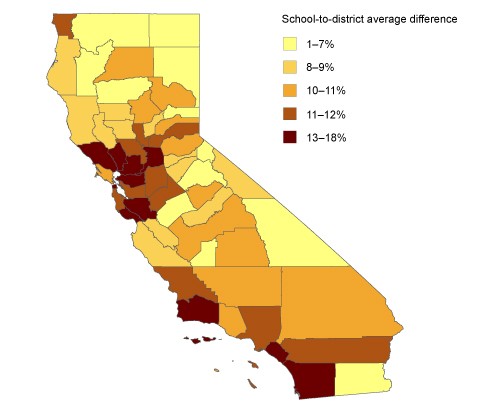Leveraging LCFF: How Can School Funding Benefit High-Needs Students?
Research in Brief
New research from the Public Policy Institute of California (PPIC) raises concerns that high-need schools in districts with comparatively low levels of high-need students may not receive adequate funding. This PPIC report highlights counties in Southern California, the Bay Area, and Sacramento that may require special attention and support to provide adequately for high-needs students due to distribution patterns. A useful resource in this report is the visual ranking of all California counties by unevenness of high-need student distribution between school and district averages.
The overhaul of California’s Educational funding system,
resulting in the Local Control Funding Formula (LCFF), led to
providing additional funds to high-need students who are
categorized as English learners, eligible to receive free- or
reduced-price lunch, or foster youth (see the California
Department of Education’s LCFF “Frequently
Asked Questions” for more information). As Michael Kirst,
president of the State Board of Education, writes:
“The new funding formula directs additional dollars to districts
with high-need students. [...] County offices of education now
have a significant oversight role in ensuring that funds for
high-need students result in additional or improved services for
them.” Clearly, though this PPIC report draws attention to
serious concern for high-need schools that may fall short under
this new funding schema, county offices of education working with
their constituent districts and schools have the power to address
these concerns.
Below is research suggesting strategies to ensure that funding
for the highest-need students is well used. One key resource is a
2014 report from the Thomas B. Fordham Institute, Financing
the Education of High-Needs Students, that offers three
solutions to improve financing public education for the students
with the highest needs. These strategies include district
cooperatives, student funding based on multiple weights, and
exceptional-needs funds.
Research on Education Financing and High-Risk Students
- Critical Choices in Post-Recession California: Investing in the Educational and Career Success of Immigrant Youth from the Migration Policy Institute (2014)
- Foster Youth and Early Implementation of the Local Control Funding Formula: Not Yet Making the Grade from SRI International (2014)
- A Comprehensive Approach to Improving Outcomes for High-Needs Students: An Equity Framework for LCFF in the Los Angeles Unified School District from the Advancement Project (2015)
- Resource Allocation: Targeting Funding for Maximum Impact from McREL (2002)
- The New “Separate and Unequal”: Using California’s Local Control Funding Formula to Dismantle the School-to-Prison Pipeline from the Community Rights Campaign of the Labor/Community Strategy Center and Black Organizing Project (2014)
- School Finance Reform: Can it Support California’s College- and Career-Ready Goal? from PACE (2013)
- Accountable for Attendance: Addressing Chronic Student Absence In Your Local Control and Accountability Plan from Attendance Works and Children Now (2013)









